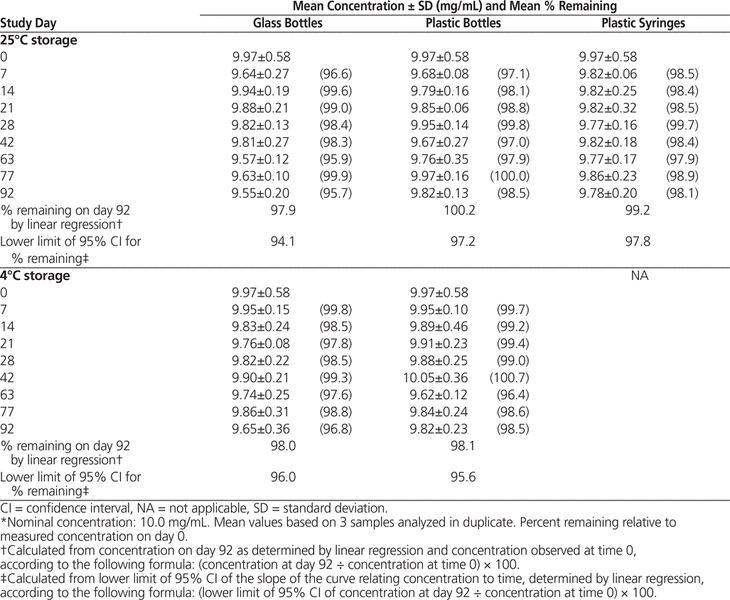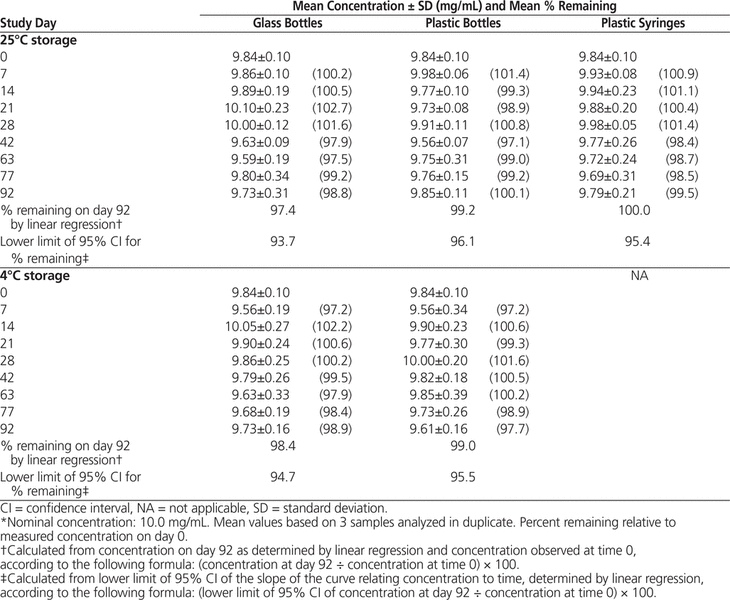
Mary H H Ensom, BS(Pharm), PharmD, FASHP, FCCP, FCSHP, Clinical Pharmacy Specialist, Diane Décarie, BSc, Research Consultant
This study evaluated the physical and chemical stability of trimethoprim suspension in commercially available dye-free vehicles at 25°C and 4°C in various containers for up to 92 days.
Stock suspensions of trimethoprim 10 mg/mL were prepared by crushing trimethoprim 100-mg tablets (AA Pharma Inc, Concord, Ontario; lot KW8605, expiry April 2016) in 400-mL volumes of each of Oral Mix and Oral Mix SF (Medisca Pharmaceutique Inc, Montréal, Quebec; lot I185/A, expiry January 2018, and lot H1136, expiry October 2017, respectively). Each suspension was divided among 6 amber glass bottles (Richards Distribution, Richmond, British Columbia), 6 amber polyethylene terephthalate prescription bottles (Richards Distribution), and twenty-five 3-mL amber plastic oral syringes (PreciseDose Dispenser System, Medisca Pharmaceutique Inc; lot 601979R/E). Three glass and 3 plastic bottles of each suspension were kept at 25°C, and the remaining bottles at 4°C. All syringes were kept at 25°C.
All samples were examined for colour, odour, taste, and ease of resuspension on days 0 (baseline), 7, 14, 21, 28, 42, 63, 77, and 92. On each study day, one 3-mL aliquot from each bottle and the contents of 3 syringes from each group were collected to determine pH (pH meter model 800, VWR International, Mississauga, Ontario). A 1.5-mL aliquot from each bottle or syringe was transferred to a threaded, tight-seal cryogenic polypropylene vial (VWR International; lot 1095990) and frozen (−85°C) until analysis by a validated, stability-indicating high-performance liquid chromatography (HPLC) – ultraviolet detection method.1–3
Stock solutions of trimethoprim 10 mg/mL were prepared from trimethoprim powder (Sigma-Aldrich, Oakville, Ontario; lot BCBN2518V, no expiry) in Oral Mix SF (Medisca Pharmaceutique; lot H1136, expiry October 2017) to construct standard curves. Naproxen powder (Sigma-Aldrich; lot SLBH7957V, no expiry) diluted to 0.20 mg/mL in HPLC-grade methanol (Fisher Scientific, Whitby, Ontario; lot 155002, no expiry) served as the internal standard. Trimethoprim standards containing 0.02 mg/mL internal standard were prepared in HPLC-grade methanol to final concentrations of 0.050, 0.070, 0.090, 0.110, 0.130, and 0.140 mg/mL, with quality controls of 0.050, 0.080, 0.100, and 0.120 mg/mL. Each sample was passed through a Gelman hydrophilic propylene 13-mm diameter, 0.45-µm microfilter (Acrodisc, Waters Corporation, Mississauga, Ontario; lot 21829235). Standard curves were generated by least-squares regression of the peak-area ratio of trimethoprim to internal standard and the concentration of each trimethoprim standard.
The HPLC instrumentation (Waters Alliance System model 2690, Waters Corporation) consisted of a delivery pump, automated 200-µL injector, XTerra RP18 4.6 × 150 mm column (Waters Corporation; lot 01803336513887), XTerra RP18 3.9 × 20 mm guard column (Waters Corporation; lot 0184352501), and ultraviolet detector set at 225 nm. The mobile phase consisted of 76% methanol and 24% 10 mmol/L ammonium formate buffer (Sigma-Aldrich; lot BCBL4456V) at pH 4.0 and 25°C. All solvents were HPLC-grade and filtered before use. Flow rate was 0.8 mL/min.
On analysis days, samples were thawed and vortex-mixed. A 0.2-mL aliquot from each thawed sample was diluted with 1.8 mL of HPLC-grade methanol and centrifuged at 5200 rpm for 5 min. Supernatant (100 µL) was diluted to a final nominal concentration of 0.100 mg/mL in HPLC-grade methanol containing 0.0200 mg/mL internal standard. Each sample (10 µL) was filtered before injection onto the column.
For accelerated degradation, trimethoprim 2.0 mg/mL suspensions were prepared (without internal standard) from 100-mg trimethoprim tablets in Oral Mix and Oral Mix SF, mixed (v/v) with water, 2N hydrochloric acid, 2N sodium hydroxide, and 10% hydrogen peroxide, then vortex-mixed and incubated for 18 h at 60°C; after incubation, the water samples were boiled for 2 min. All samples were cooled to 25°C and centrifuged. Supernatant (0.2 mL) was diluted in HPLC-grade methanol to 0.10 mg/mL, filtered, and injected onto the column.
Regression analysis showed coefficients of determination (r2) above 0.997 (n = 4). Intraday and interday coefficients of variation for quality control samples were 1.43% and 2.63%, respectively, for 0.050 mg/mL solution; 0.59% and 0.86%, respectively, for 0.080 mg/mL solution; 0.89% and 1.18%, respectively, for 0.100 mg/mL solution; and 1.07% and 1.18%, respectively, for 0.120 mg/mL solution. Intraday and interday accuracy values (mean ± standard deviation) were 97.74% ± 0.60% and 97.27% ± 1.53%, respectively, for 0.050 mg/mL solution; 99.27% ± 0.74% and 99.15% ± 0.64%, respectively, for 0.080 mg/mL solution; 99.16% ± 0.71% and 99.06% ± 0.91%, respectively, for 0.100 mg/mL solution; and 99.38% ± 0.40% and 99.12% ± 0.85%, respectively, for 0.120 mg/mL solution.
Retention times were 2.15 min for trimethoprim and 4.02 min for the internal standard. With forced degradation, no interfering peaks were generated; the trimethoprim peak decreased by 19.2%–30.1% in Oral Mix and by 20.2%–26.3% in Oral Mix SF. Minor, non-interfering peaks were observed at 1.72, 2.47, 3.09, and 3.68 min. Time 0 samples stored for 92 days at −85°C showed no degradation products and contained the expected concentration of trimethoprim.
No precipitate formed up to day 63, at which point some granules were observed in the suspensions. All suspensions were easily resuspended. No notable changes in milky white colour, acidic taste, or sweet-cherry odour of suspensions occurred. Mean pH remained stable (6.04–6.11 in Oral Mix, 6.09–6.20 in Oral Mix SF). HPLC analyses showed that all suspensions maintained more than 90% of their original concentration for up to 92 days (Tables 1 and 2).
Table 1. Concentration of Trimethoprim in Oral Mix Suspension Vehicle During 92 Days of Storage in Glass Bottles, Plastic Bottles, and Plastic Syringes at 25°C and in Glass and Plastic Bottles at 4°C*
Table 2. Concentration of Trimethoprim in Oral Mix SF Suspension Vehicle During 92 Days of Storage in Glass Bottles, Plastic Bottles, and Plastic Syringes at 25°C and in Glass and Plastic Bottles at 4°C*
In conclusion, trimethoprim suspensions (10 mg/mL) in Oral Mix and Oral Mix SF remained stable for up to 92 days in glass and plastic bottles (25°C or 4°C) or syringes (25°C).
1. Ghanem MM, Abu-Lafi SA. Validation of a stability-indicating RP-HPLC method for the simultaneous determination of trimethoprim and sulfadimethoxine sodium in oral liquid dosage form. Sci Pharm. 2013;81(2):459–74.


2. Ghanem MM, Abu-Lafi SA. Development and validation of a stability-indicating HPLC method for the simultaneous determination of sulfadiazine sodium and trimethoprim in injectable solution formulation. Sci Pharm. 2013;81(1):167–82.


3. Ensom MHH, Décarie D, Lingertat-Walsh K. Stability of extemporaneously compounded naproxen 25 mg/mL suspension in glass and plastic bottles and plastic syringes. Can J Hosp Pharm. 2015;68(6):489–93.

Mary Ensom is also a Professor, Faculty of Pharmaceutical Sciences, and Distinguished University Scholar, The University of British Columbia, Vancouver, British Columbia. ( Return to Text )
Funding: This study was funded by an unrestricted educational grant from Medisca Pharmaceutique Inc.
Competing interests: Other than grant support, no competing interests were declared.
Canadian Journal of Hospital Pharmacy, VOLUME 69, NUMBER 2, March-April 2016